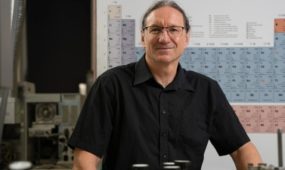Connolly to head up Mars mission
Education
A LEADING rocket scientist is returning to NASA to head up the push to send humans to Mars.

Sign up to receive notifications about new stories in this category.
Thank you for subscribing to story notifications.
Former NASA Chief Exploration Scientist John Connolly has been on loan to the International Space University as its Space Studies Program Director since March 2014.
Connolly will return to NASA to lead the Human Mars Mission Planning at the NASA Johnson Space Centre in Houston, Texas, in September.
The 28-year NASA veteran is in South Australia this month running ISU’s Southern Hemisphere Space Studies Program.
ParkesAldrin’s
The state of South Australia has a dynamic aerospace industry and will host more than 3000 delegates at the International Astronautical Congress (IAC) in September 2017 at the Adelaide Convention Centre.
Adelaide’s University of South Australia has also hosted the Southern Hemisphere Space Studies program five times since 2011.
Connolly said he had mixed feelings about the move back to Houston.
“I love ISU. Every time I come to an ISU program just the energy of the students recharges my batteries but NASA is in a transition, we have a new president coming in shortly.
“NASA will likely get new directions from the new president and I’m needed when that happens so the timing is right for me to go back.
“Mars is the future destination we want to get to and the issue has always been what are the steps between where we are now and Mars so that’s what I’m taking over when I get back.”
“My career has been mainly about trying to get people back to the moon and on to Mars and exploring space – the whole business of exploration, which is what NASA is supposed to be all about.”
Connolly said he believed a manned Mars landing was possible during his lifetime.
“I certainly hope so – when I was nine watching Neil and Buzz walking on the moon, I thought we would be on Mars in the next year or two then I went to work for NASA and the moon program had wound down already and the shuttle program was starting up and then I thought Mars was just around the corner as well.
“I am still undaunted by the passage of time, it’s going to happen it’s only a matter of when and who does it. Is it a single government? Is it a collection of governments like the international space station? Is it a private company that has a lot of resources and the ability to do it?
But why Mars?
“Because it’s next. There’s this history of human exploration which starts with us crawling out of the caves I suppose and wondering what’s over the next mountain range and climbing that mountain range, wondering what’s over the ocean and sailing the oceans, going to the moon in 1969 and Mars is the next target.
“We are explorers by our DNA – just watch a nine-month-old opening your kitchen cabinets if you don’t believe that – I think it’s just something inside all of us that wants to find out what’s beyond the next hill and Mars is the next hill.”
US Federal Government funding to NASA has been decreasing in real terms for many years.
It peaked at 4.41 per cent of the total US Budget in 1966 but now represents only about 0.5 per cent. This equated to about $US 17.6 billion in 2014.
However, Connolly said the global space industry was transitioning away from the dominance of government agencies, which started the industry during the Cold War, to more commercial space entities.
The global space industry grew by nine per cent to $330 billion in 2014.
“Those start-ups have tended to be mostly in the US but now we’re starting to see them in Europe, New Zealand and Australia so we’re starting to see a transition away from space being purely a government endeavor to being something that there’s more and more commercial participation in.
“Satellites are where it started – the first spin-off into the commercialization was telecommunications, which has grown into a multi-billion dollar industry now run primarily by commercial companies.
“What we’re seeing now is more companies want to get into the business of the launch. So we have SpaceX on the high end and a bunch of smaller launch companies that have come in recently.
“We have commercial companies that are building satellites, especially small satellites – the big satellites we had decades ago we can shrink them down into a small cube now so we have companies that specialize in these small very powerful little satellites.
CubeSat miniature satellites used for space research are typically 10cm cubes with a weight of less than 1.33kgs.
Connolly said the cheaper mini satellites had allowed many schools and universities to launch their own satellites for research projects.
“Now space all of a sudden is accessible to many more people because things are smaller and less expensive and you have schools around the world that have satellites in orbit, which is amazing.”
In 2014 alone, there were close to 300 satellite launches. Almost half of those were satellites weighing 10kgs or less.
Jump to next article



